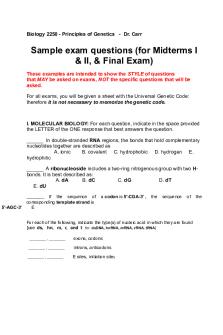Biomass exam questions PDF

| Title | Biomass exam questions |
|---|---|
| Course | Biology - A1 |
| Institution | Sixth Form (UK) |
| Pages | 3 |
| File Size | 179.1 KB |
| File Type | |
| Total Downloads | 105 |
| Total Views | 149 |
Summary
Biomass exam questions...
Description
Q1. Students investigated a food chain in a garden. lettuce
→
snail
→
thrush (bird)
The students: • estimated the number of lettuce plants in the garden • estimated the number of snails feeding on the lettuces • counted two thrushes in the garden in 5 hours. The table below shows the students’ results and calculations. Organism
Population size Mean mass of each organism in g
Lettuce Snail Thrush (a)
(i)
Biomass of population in g
Biomass from previous organism that is lost in g
Percentage of biomass lost
50
120.0
6000
200
2.5
500
5500
91
2
85.0
170
330
66
Give two ways that biomass is lost along a food chain. Some of the mass is lost in faeces or not all of the animal/plant is eaten. (2)
(ii)
Scientists estimate that about 90% of the biomass in food is lost at each step in a food chain. Suggest one reason why the students’ value for the percentage of biomass lost between the snails and the thrushes is only 66%. Thrushes eat other things. (1)
(b)
European banded snails have shells with different colours (light or dark) and with stripes or with no stripes. Figure 1 shows two examples of European banded snails. Figure 1
Page 1 of 3
© Eric Lsselee/iStock
© filipfoto/iStock
Figure 2 shows results from surveys in woodlands and in grasslands of the percentage of snails with light-coloured shells and the percentage of snails with no stripes. Each point on the graph represents the results of one survey in one habitat. Figure 2
(i)
Figure 2 is a scatter graph. Why is a scatter graph used for this data? There are two dependent variables. (1)
Page 2 of 3
(ii)
Compare the general appearance of snails that live in woodlands with the general appearance of snails that live in grasslands. More snails with light coloured shells live in grass land. Whereas, more snails with no stripes live in woodlands. (2)
(iii)
Suggest a reason for the general appearance of snails that live in woodlands. To camouflage into the surroundings. (1) (Total 7 marks)
Page 3 of 3...
Similar Free PDFs

Biomass exam questions
- 3 Pages

Biomass energy ppt
- 44 Pages

Exam, questions
- 1 Pages

Exam Questions
- 9 Pages

Exam, questions
- 7 Pages

Exam, questions
- 9 Pages

Exam, questions
- 62 Pages

Exam, questions
- 8 Pages

Exam, questions
- 5 Pages

Exam, questions
- 5 Pages

Exam, questions
- 2 Pages

Exam, questions
- 10 Pages

Exam, questions
- 2 Pages

Exam, questions
- 24 Pages

EXAM, questions
- 6 Pages

Exam, questions
- 8 Pages
Popular Institutions
- Tinajero National High School - Annex
- Politeknik Caltex Riau
- Yokohama City University
- SGT University
- University of Al-Qadisiyah
- Divine Word College of Vigan
- Techniek College Rotterdam
- Universidade de Santiago
- Universiti Teknologi MARA Cawangan Johor Kampus Pasir Gudang
- Poltekkes Kemenkes Yogyakarta
- Baguio City National High School
- Colegio san marcos
- preparatoria uno
- Centro de Bachillerato Tecnológico Industrial y de Servicios No. 107
- Dalian Maritime University
- Quang Trung Secondary School
- Colegio Tecnológico en Informática
- Corporación Regional de Educación Superior
- Grupo CEDVA
- Dar Al Uloom University
- Centro de Estudios Preuniversitarios de la Universidad Nacional de Ingeniería
- 上智大学
- Aakash International School, Nuna Majara
- San Felipe Neri Catholic School
- Kang Chiao International School - New Taipei City
- Misamis Occidental National High School
- Institución Educativa Escuela Normal Juan Ladrilleros
- Kolehiyo ng Pantukan
- Batanes State College
- Instituto Continental
- Sekolah Menengah Kejuruan Kesehatan Kaltara (Tarakan)
- Colegio de La Inmaculada Concepcion - Cebu